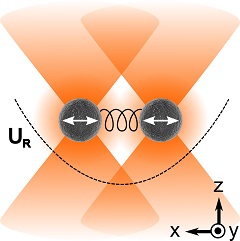Coupled with light – two particles are better than one
So often in life we hear that size matters, in the world of quantum physics it really does.
New research, led by the University of St Andrews and the College of Optical Sciences, The University of Arizona, has led to the ability to trap two miniscule spinning particles, which offers fascinating insights into the world around us and could help create future precise sensors for measurement.
Quantum physics describes the world of atoms, molecules and the fundamental building blocks of light, namely photons. An intriguing question is how we observe quantum effects in larger objects. This would help bridge our understanding between the world around us and the puzzling, but ever more important, domain of quantum physics.
 Each particle is around the size of a cell, albeit small, but much larger than a single atom or molecule. Laser light acts as a tractor beam, trapping each particle in vacuum, away from any surface. This is important as the particle does not touch anything so it cannot easily exchange energy (and lose its ‘quantum’ nature) as there is no contact with the surroundings. This makes these particles ideal for future studies of quantum physics with ‘large’ objects.
Each particle is around the size of a cell, albeit small, but much larger than a single atom or molecule. Laser light acts as a tractor beam, trapping each particle in vacuum, away from any surface. This is important as the particle does not touch anything so it cannot easily exchange energy (and lose its ‘quantum’ nature) as there is no contact with the surroundings. This makes these particles ideal for future studies of quantum physics with ‘large’ objects.
The research, published in the journal Optica (25 July 2018), found that each particle scattered light which influenced the other’s motion. This created a coupled oscillator, with the coupling created by a spring made solely of light, paving the way for new studies between the classical and quantum world.
Dr Yoshihiko Arita, School of Physics and Astronomy at the University of St Andrews, said: “We can study new effects such as energy exchange in this system or even test if the vacuum has friction. It’s a real test bed for new science.”
Professor Kishan Dholakia also from the School of Physics and Astronomy added: “This is an important, collaborative project in a burgeoning field which could lead to some startling breakthroughs.”
The paper ‘Optical binding of two cooled micro-gyroscopes levitated in vacuum’ is published in the journal Optica and is available online.
Please ensure that the paper’s DOI (doi.org/10.1364/OPTICA.5.000910) is included in all online stories and that Optica is credited as the source.
The research builds on previous work by the group creating the fastest man-made rotation with a single spinning particle. The work is supported by the UK Engineering and Physical Sciences Research Council.
Contact the University of St Andrews Communications Office.